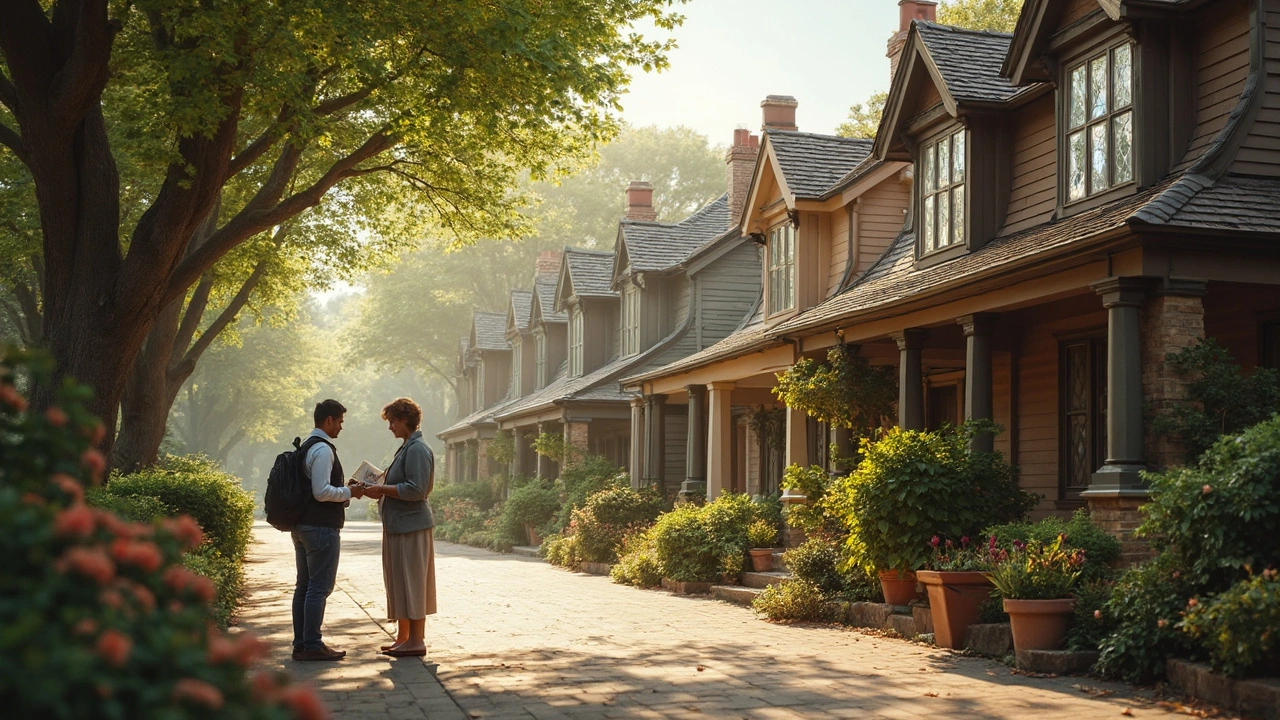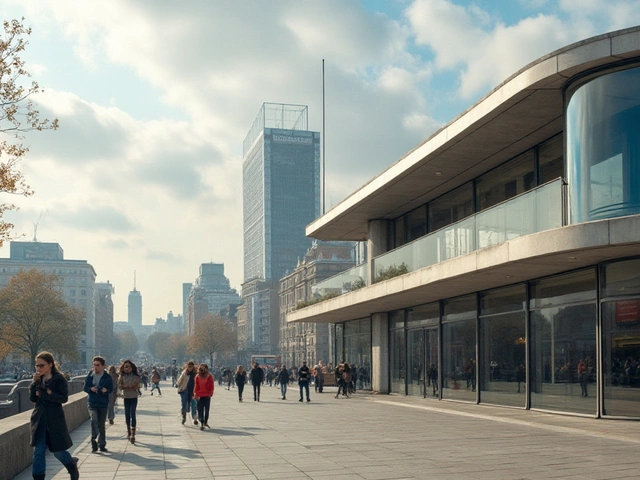Imagine walking up to a house with a sturdy porch, chunky columns, hand-made woodwork, and the kind of windows that make you want to sit and read a book. That’s American Craftsman right there. There’s a reason these homes still turn heads—over a hundred years after they first showed up in the U.S.
But Craftsman style isn’t just about looking good. It started as a pushback against cookie-cutter houses and mass production. People wanted homes that felt personal, with features built to last. You see all those exposed rafters, wide eaves, and built-in shelves? They’re not just for show. They’re all about function, comfort, and a sense of quality you can actually see and touch.
If you’ve ever wondered why Craftsman homes have such a loyal following, you’re not alone. Real estate agents will tell you buyers go nuts for original details, from the fireplace tiles to the hardwood floors. Even newer homes copy these touches, trying to capture that same handcrafted feel.
Whether you own a Craftsman, are house-hunting, or just want to borrow some of that timeless style, knowing what makes these houses special is a great place to start. Let’s get straight to what makes this look so American—and why people can’t stop loving it.
- Roots of the Craftsman Style
- Spotting a Craftsman Home
- Real-Life Examples and Trends
- Tips for Bringing Craftsman Charm Home
Roots of the Craftsman Style
The American Craftsman style kicked off around 1905, but its roots go back even further. It was part of the larger Arts and Crafts movement, which started in Britain as a reaction against cheap, mass-produced furniture and homes from the Industrial Revolution. Folks wanted quality over quantity—and wanted homes that felt real, not just factory-made.
The whole thing caught on fast in the U.S. thanks to magazines like Gustav Stickley’s ‘The Craftsman,’ which showed off home plans and furniture anyone could actually build. Stickley is the name to know—he was a furniture maker and basically the face of Craftsman in America. Even major companies like Sears jumped in, selling mail-order Craftsman house kits you could buy and build yourself. Seriously—over 70,000 of these kit homes shipped out between 1908 and 1940.
This style was a hit because it made good design affordable for middle-class families. Homes were smaller than the Victorian mansions before them, but every inch was thought out. Things like built-in storage, cozy nooks, and a strong indoor-outdoor connection became the default, not the exception.
- Emphasis on handiwork and visible construction
- Lots of local, natural materials—think wood and stone
- Simple floor plans for easier living
People loved how these houses felt warm, practical, and honest. If you’re looking for stats, check out this quick rundown showing just how explosive the growth was, especially on America’s West Coast where cities like Pasadena, CA, became ground zero for Craftsman fandom:
| Year | Estimated Craftsman Homes Built (US) |
|---|---|
| 1905 | 500 |
| 1915 | 24,000 |
| 1925 | 65,000 |
The bottom line? Craftsman homes took off because they hit that sweet spot between beautiful design, affordability, and everyday comfort. That’s why you still see so many neighborhoods filled with these solid, inviting houses.
Spotting a Craftsman Home
If you ever feel stumped telling a Craftsman apart from other houses, you’re not alone. The trick is knowing what details to look for. Most American Craftsman homes have a few dead giveaways you can spot from the sidewalk.
- Low-pitched, gabled roofs: Look for roofs with a gentle slope and wide, overhanging eaves. Sometimes the rafters stick out where you can actually see them.
- Big, inviting front porches: Usually held up by thick square or tapered columns that sit on stone or brick piers. These porches are built for afternoons with a cold drink, not just for show.
- Exposed beams and brackets: Craftsman homes wear their support structures on their sleeves. Decorative brackets under the eaves and visible beams aren’t just for looks—they’re part of the house’s bone structure.
- Double-hung windows: You’ll notice these often have a grid of small panes on the top, with a single pane on the bottom. Lots of light, plus a bit of old-school charm.
- Built-ins everywhere: Many Craftsman homes come with built-in benches, shelves, and bookcases—handy and good-looking, so you don’t have to buy a ton of furniture to fill empty corners.
Here’s a quick comparison of features you’ll find on most Craftsman homes versus other classic American styles:
| Feature | Craftsman | Colonial | Victorian |
|---|---|---|---|
| Roof Pitch | Low, gabled | Medium-high, side-gabled | Steep, complex |
| Front Porch | Large, covered | Simple, small | Sometimes present, usually decorative |
| Window Style | Double-hung, divided top sash | Symmetrical, single or double-hung | Bay and stained-glass windows |
| Material | Wood, stone, brick | Brick or wood | Wood, lots of trim |
| Built-ins | Common | Rare | Less common |
One cool fact—most real Craftsman homes were built between 1905 and the early 1930s, mainly because of Gustav Stickley’s pattern books and mail-order kits from Sears. That’s right, you could literally pick out your dream house, have it delivered by train, and build it on your plot of land.
Next time you’re checking out houses, look for those big porches, chunky pillars, and exposed woodwork. If you see a house that just feels solid, welcoming, and a bit back-to-basics, odds are you’re looking at classic Craftsman.

Real-Life Examples and Trends
If you want to see American Craftsman style at its best, head to Pasadena, California. The Gamble House—built in 1908 by the Greene brothers—is basically the poster child for Craftsman homes. People travel from all over just to see those crazy-detailed wood joints and stained glass windows. This place didn’t just stick to its original look, either. It inspired a whole neighborhood that’s packed with similar homes.
But Craftsman style isn’t just stuck in California. In Seattle, the whole Wallingford district is like a living museum for this look. Places like Minneapolis, Chicago, and Portland all have whole blocks of these homes. According to Redfin, in 2024 Craftsman homes sold, on average, 15% faster than other house styles in cities where there’s a big stock of them. People love that you can walk into a Craftsman bungalow and it feels solid—like the walls have actually seen some life.
“The best thing about a true Craftsman home? It’s never boring. The details suck you in, and there’s this unspoken promise that the place will stand the test of time.”
— Mark Richardson, Historic Home Appraiser
You’ll usually spot trends like:
- Restoration over replacement—folks are ripping up carpets to restore fir floors, not slapping down vinyl.
- Pops of color coming back—especially deep greens, ochre, and natural wood stains.
- Open shelves and built-in benches making a comeback, even in new builds.
- Backyard ADUs (Accessory Dwelling Units) are being done up in matching Craftsman style for extra rental space.
Numbers don’t lie. Here’s a quick look at recent buyer data for traditional Craftsman homes compared to other styles:
| Year | Average Sale Price (Craftsman) | Average Days on Market (Craftsman) | Average Days on Market (Other styles) |
|---|---|---|---|
| 2022 | $715,000 | 19 | 27 |
| 2023 | $753,000 | 17 | 26 |
| 2024 | $784,000 | 16 | 25 |
All those numbers mean Craftsman homes keep holding their value—and then some. The demand hasn’t really slowed down. Sure, modern builders might cut corners, but buyers keep coming back to that American Craftsman feeling: solid wood, real workmanship, and a design that just feels right year after year.
Tips for Bringing Craftsman Charm Home
If you want your space to feel like a true American Craftsman home, you don’t have to gut everything or hire pricey architects. A few well-placed updates go a long way. Authenticity is the goal. Even small details pack a punch if you pick the right ones.
Start with the porch. Craftsman homes are famous for their deep porches and thick, tapered columns. Even if your place doesn’t naturally have these, you can fake it with box columns made from wood. Choose a muted color like olive green, navy, or a warm brown since the originals always leaned into earthy, natural shades.
For the inside, focus on built-ins. These aren’t just pretty; they’re practical. Think benches under windows, shelving with simple lines, or bookcases that flank a fireplace. According to Bob Vila, the home improvement guru,
"Built-in furniture, from cabinetry to benches, is one hallmark of the Craftsman style that you can bring into any home for instant character."
- Swap out basic trim for chunky window and door casings. Keep it simple—no frills, just wide, squared-off wood with visible grain.
- Choose lighting with stained glass or simple, geometric shapes. Reproduction brass or bronze fixtures capture that early-1900s vibe.
- Keep walls neutral—think soft beige, moss green, or eggshell. Let the wood details stand out.
- Look for hardware in aged brass or oil-rubbed bronze. Avoid anything shiny or too modern.
Floors should be real wood if possible—oak and fir were the originals. If you’re on a budget, laminate in a natural wood tone also works. For rugs, try a simple geometric pattern or even a vintage-style one in muted colors.
Don’t forget about the finishing touches. Pottery, hand-thrown ceramics, and even some mission-style furniture go a long way. The goal is to keep things relaxed but intentional—each piece feels chosen, not just stuck in for looks.
You don’t need to recreate a historical showpiece. Even adding one or two classic Craftsman touches can make any home feel warmer, cozier, and built with care.





